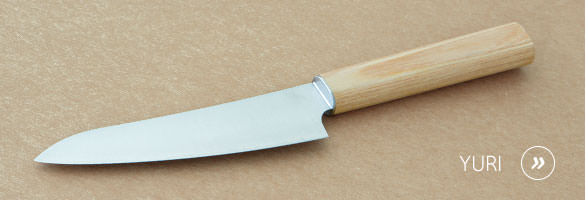Glossary
HRC
The hardness of cutting steels is specified using the unit Rockwell C (HRC). The usual values for simple utility knives are 50 - 55 HRC, for outdoor knives between 55 - 60 HRC and for Japanese chef's knives between 59 - 67 HRC.
The Rockwell hardness is determined using a diamond cone loaded with 10kg by measuring the indentation depth in the steel. This is also what the C (cone) in the designation HRC stands for. The hardness measurement in the cutting edge area of chef's knives must be carried out using a complex micro-hardness test. It is therefore often the case that only the hardness of the matrix is measured and not the embedded carbides.
Effect of the different Rockwell hardnesses on the knives
The specified hardness is an indication of how sharp a knife can be sharpened. The higher the HRC, the sharper the edge of the knife can be ground. However, hardness does not only have advantages. A knife from the Yuri series, for example, was forged with AUS-8 steel and has an HRC of approx. 59. The knife cannot be sharpened quite as sharply, but is more forgiving of a mishap in the cutting action, such as levering or tilting. The somewhat more flexible knife is therefore more suitable for amateur chefs who are not yet familiar with Japanese knives.A knife such as the Kyusakichi Damascus knife, which is made from the powder metallurgical ZDP-189 premium steel, has an HRC of approximately 66 - 67. The knife steel can be ground to a much sharper edge. However, this can lead to chipping on the cutting edge much more quickly if the knife is cut incorrectly. Japanese knives with a higher hardness are therefore more suitable for professionals or chefs who already have experience with these knives. Important note: Japanese chef's knives should always be used with a pushing or pulling cut.

